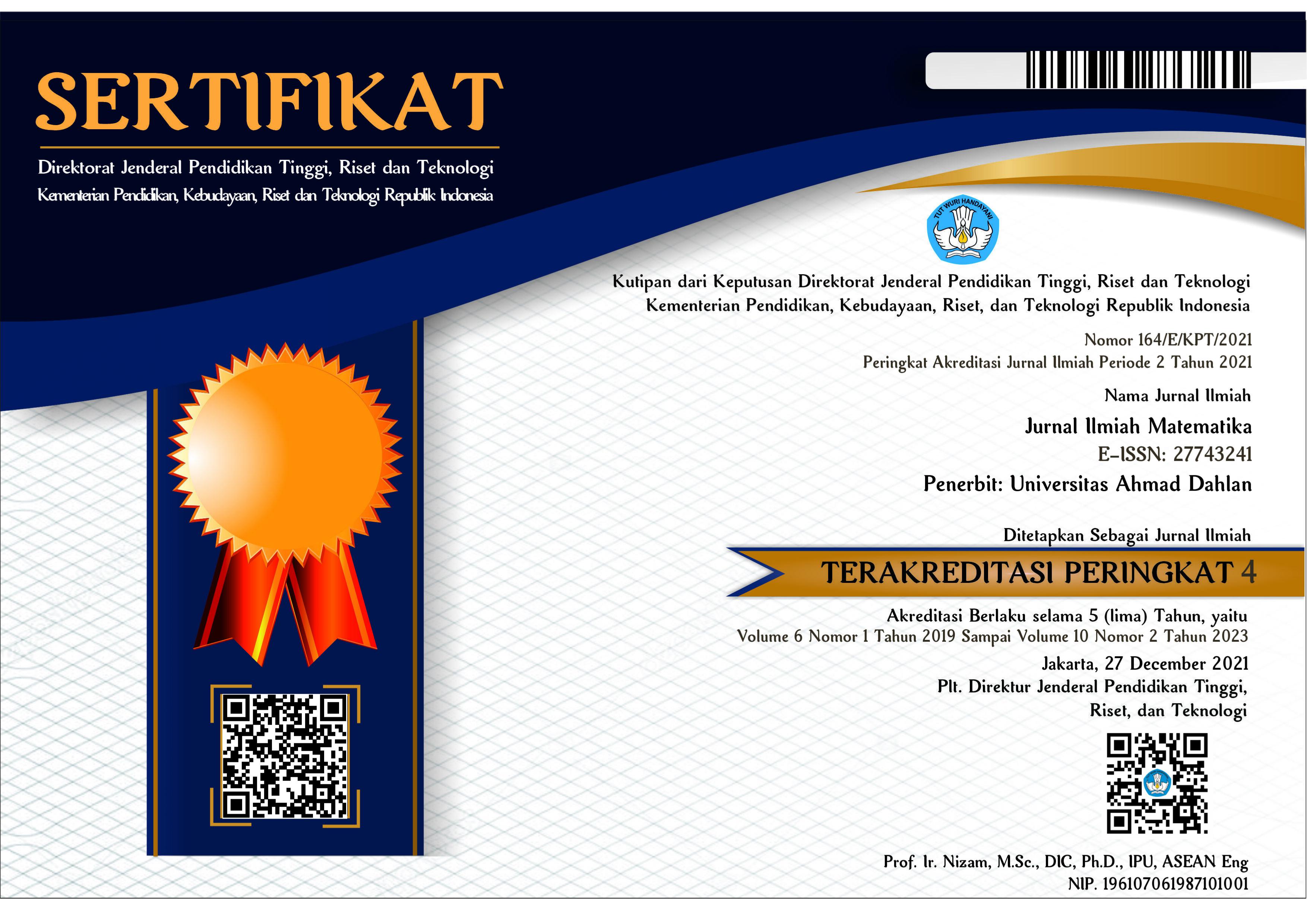Pemodelan Stokastik dan Probability of Extinction Penyebaran Penyakit Kaki gajah
DOI:
https://doi.org/10.26555/konvergensi.v9i1.21848Abstract
Model stokastik berbasis Continous Time Markov Chain untuk dinamika penyebaran penyakit kaki gajah diformulasi dan probability of extinction atau peluang kepunahan ditentukan. Hasil penelitian menunjukkan bahwa kepunahan penyakit akan semakin besar apabila jumlah individu terinfeksi pada awal epidemik kecil.References
M. Z. Ndii, A. R. Mage, J. J. Messakh, and B. S. Djahi, “Optimal vaccination strategy for dengue transmission in kupang city, indonesia,†Heliyon, vol. 6, no. 11, p. e05345, 2020.
E. Banni, M. Kleden, M. Lobo, and M. Ndii, “Estimasi reproduction number model matematika penyebaran malaria di sumba tengah, indonesia,†Jambura Journal of Biomathematics, vol. 2, no. 1, 2021.
H. S. Panigoro, E. Rahmi, N. Achmad, and S. L. Mahmud, “The influence of additive allee effect and periodic harvesting to the dynamics of leslie-gower predator-prey model,†Jambura Journal of Mathematics, vol. 2, no. 2, pp. 87–96, 2020.
D. Tambaru, B. S. Djahi, and M. Z. Ndii, “The effects of hard water consumption on kidney function: Insights from mathematical modelling,†AIP Conference Proceedings, vol. 1937, no. 1, p. 020020, 2018.
Y. Adi and A. Thobirin, “Backward bifurcation in a within-host tuberculosis model,†Advances in Mathematics: Scientific Journal, vol. 9, no. 9, 2020.
R. U. Hurint, M. Z. Ndii, , and M. Lobo, “Analisis sensitivitas dari model epidemi seir,†Natural Science: Journal of Science and Technology, 2017.
P. K. N. Salonga, V. M. P. Mendoza, R. G. Mendoza, and V. Y. Belizario, “A del of the dynamics of lymphatic filariasis in caraga region, the philippines,†Royal Society Open Science, vol. 8, no. 6, p. 201965, 2021.
H. Tasman, T. Supali, A. K. Supriatna, N. Nuraini, and E. Soewono, “A mathematical model for long-term effect of diethylcarbamazine-albendazole mass drug administration on lymphatic filariasis,†AIP Conference Proceedings, vol. 1651, no. 1, pp. 138–146, 2015.
P. M. Mwamtobe, S. M. Simelane, S. Abelman, and J. M. Tchuenche, “Mathematical analysis of a lymphatic filariasis model with quarantine and treatment,†BMC Public Health, vol. 17, p. 265, Mar. 2017.
M. A. Irvine, L. J. Reimer, S. M. Njenga, S. Gunawardena, L. Kelly-Hope, M. Bockarie, and T. D. Hollingsworth, “Modelling strategies to break transmission of lymphatic filariasis - aggregation, adherence and vector competence greatly alter elimination,†Parasites & Vectors, vol. 8, p. 547, Oct. 2015.
P. Jambulingam, S. Subramanian, S. J. de Vlas, C. Vinubala, and W. A. Stolk,“Mathematical modelling of lymphatic filariasis elimination programmes inIndia: required duration of mass drug administration and post-treatment level of infection indicators,†Parasites & Vectors, vol. 9, p. 501, Sept. 2016
Downloads
Published
Issue
Section
License
Authors who publish with this journal agree to the following terms:
1. Authors retain copyright and grant the journal right of first publication with the work simultaneously licensed under a Creative Commons Attribution License that allows others to share the work with an acknowledgment of the work's authorship and initial publication in this journal.
2. Authors are able to enter into separate, additional contractual arrangements for the non-exclusive distribution of the journal's published version of the work (e.g., post it to an institutional repository or publish it in a book), with an acknowledgment of its initial publication in this journal.
3. Authors are permitted and encouraged to post their work online (e.g., in institutional repositories or on their website) prior to and during the submission process, as it can lead to productive exchanges, as well as earlier and greater citation of published work.

This work is licensed under a Creative Commons Attribution-ShareAlike 2.0 Generic License.









